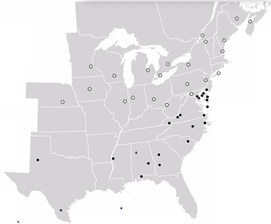|
written by: Darsy Smith & Veronica Yurchak Dr. Galen Dively, a Professor Emeritus in the Department of Entomology at the University of Maryland, has become a leading figure in the effort to monitor and mitigate resistance development to genetically modified Bt corn, primarily addressing the very destructive corn earworm. At this week’s colloquium, Dr. Dively presented on his work designing a new approach for monitoring insect resistance in Bt corn, as well as how this approach is changing the way genetically modified crop technologies are regulated by the EPA. Bt toxins are insecticidal crystalline (Cry) and vegetative (Vip) proteins produced naturally by the soil bacterium Bacillus thuringiensis. Pesticide sprays containing the Cry proteins are known as Bt pesticides and have been used for pest control in organic agriculture and ornamental landscapes for nearly 90 years. However, the use of Bt sprays in conventional agriculture has been limited due to inconsistent field performance caused by its tendency to break down quickly in UV light. As a solution, scientists and seed companies created genetically modified (GM) plants capable of expressing these insecticidal proteins within the tissue of the growing crop plant. Since their initial introduction in 1996, Bt crops have become one of the most rapidly adopted agricultural technologies, with the most common Bt crops being corn and cotton. The popularity of Bt corn in conventional agriculture is due to the fact that plants are protected from damage caused by several major corn pests including the corn rootworm, European corn borer, the corn earworm, the fall armyworm, and western bean cutworm from seedling emergence all the way through harvest. As is common with any pesticide product, insect resistance development is a major threat to the Bt crop technology. Scientists, regulators and industry personnel have been actively monitoring the development of resistance in a number of these target pests. Traditionally, resistance to and Bt corn is monitored using bioassays, or feeding trials where field collected insect pests are fed a diet containing the Cry proteins, and their development and survival is studied in a lab. Susceptible insects would be killed or made very sick, while those developing resistance to the Cry proteins would continue to grow and develop. After observing faults with this method, Dr. Dively decided there may be a more effective way to monitor for Bt resistance, particularly in caterpillar pests.
Based on these findings and the overall success of the sentinel plot monitoring network at detecting practical, field-evolved resistance, Dr. Dively and other researchers have recommended changes be made to the regulatory resistance monitoring process for Bt crops. Currently, for every new Bt variety introduced, an Insect Resistance Management (IRM) plan is required. These IRM plans have four basic components: 1) a high dose – refuge strategy in which the toxin expression is high enough to kill all target individuals except for the rare homozygous resistant ones, and where a certain percentage of non-Bt corn must also be planted in order to ensure the development of susceptible insects; 2) new varieties containing multiple proteins toxic to the target pest; 3) the development of resistance must be monitored; and 4) a mitigation action plan must be presented. As a direct result of Dr. Dively’s research, the EPA has proposed a number of changes to the IRM plans to slow the development of insect resistance by increasing the number of susceptible insects in the overall population as well as ensure only varieties expressing multiple Bt toxins are planted. Due to the fact that Bt crop technology has become the foundation of corn and cotton pest management in the United States, it is extremely important ensure that the best resistance management practices are being implemented in order to extend the efficacy of this technology as long as possible. Dr. Dively’s research has identified a fantastic way to actively detect resistance development across the country and has spurred a number of proposed changes at the regulatory level, hopefully securing the effectiveness of these GM technologies for years to come.
Comments are closed.
|
Categories
All
Archives
June 2024
|
Department of Entomology
University of Maryland
4112 Plant Sciences Building
College Park, MD 20742-4454
USA
Telephone: 301.405.3911
Fax: 301.314.9290
University of Maryland
4112 Plant Sciences Building
College Park, MD 20742-4454
USA
Telephone: 301.405.3911
Fax: 301.314.9290



 RSS Feed
RSS Feed




